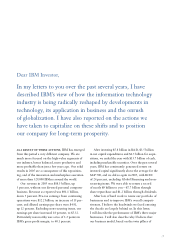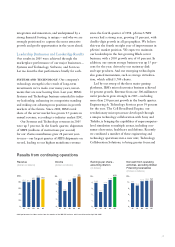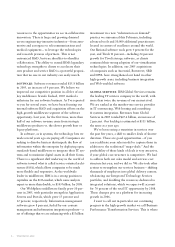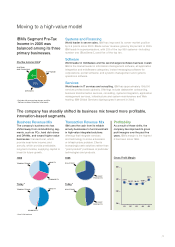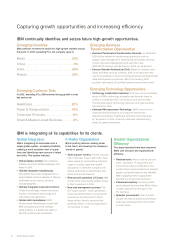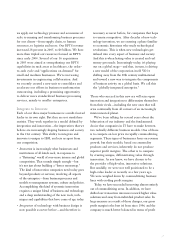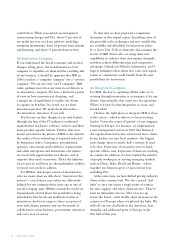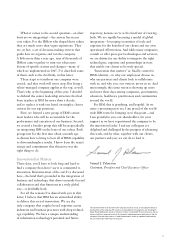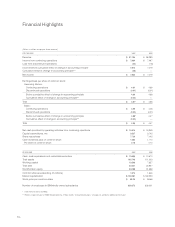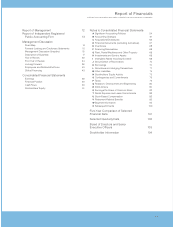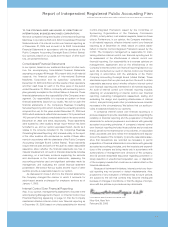IBM 2005 Annual Report Download - page 8
Download and view the complete annual report
Please find page 8 of the 2005 IBM annual report below. You can navigate through the pages in the report by either clicking on the pages listed below, or by using the keyword search tool below to find specific information within the annual report.we apply our technology prowess and economies of
scale to running and transforming business processes
for our clients
—
from supply chain, to human
resources, to logistics and more. Our BPTS revenue
increased 28 percent in 2005, to $4billion. We have
more than tripled our resources focused on BPTS
since early 2004. Several of our 16 acquisitions
in 2005 were aimed at strengthening our BPTS
capabilities in such areas as healthcare, the order-
to-cash cycle and “applications on demand” for
small and medium businesses. We’re increasing
investments in engineering collaboration. And
we recently created a new unit to consolidate and
accelerate our efforts in business transformation
outsourcing, including a promising opportunity
to deliver more standardized business processing
services, mainly to smaller enterprises.
Integrate to Innovate
Each of our three major businesses is a multi-faceted
leader in its own right. But they are not standalone
entities. They work together in a model defined by
integration and innovation
—
the imperatives that we
believe are increasingly shaping business and society
in the 21st century. This ability to integrate and
innovate is unique to IBM, and sets us apart from
our competition.
•Innovation is increasingly what businesses and
institutions of all kinds seek, in response to
a “flattening” world of ever-more intense and global
competition. That sounds simple enough
—
but
it’s not just about building a “better mousetrap.”
The kind of innovation companies need today goes
beyond products or services, involving all aspects
of the enterprise
—
from business processes and
models to management systems, culture and policies.
Accomplishing this kind of systemic innovation
requires a unique blend of business and technology,
and a deep understanding of the new tools, tech-
niques and capabilities that have come of age today.
•Integration of technology with business design is
now possible as never before
—
and therefore is
necessary as never before, for companies that hope
to remain competitive. After decades of new tech-
nology invention, we are entering a phase familiar
to economic historians who study technological
revolutions. This is when new technologies get
infused into every aspect of business and society.
And this is when lasting value is created and real
money gets made. Increasingly today, it’s playing
out on a global stage
—
and that, in turn, is driving
a new model of the corporation itself. We’re
shifting away from the 20th century multinational
and toward a new way to integrate the components
of business activity on a global basis. We call this
the “globally integrated enterprise.”
Those who succeed in this new era will seize upon
innovation and integration to differentiate themselves
from their rivals
—
including the new ones that will
arise continually from all corners of an increasingly
interconnected planet.
We’ve been talking for several years about the
bifurcation of our industry and the fundamental
choice that companies in IT have to make between
two radically different business models. One of those
is to compete on low price in rapidly commoditizing
segments. These types of businesses focus on revenue
growth, but their models, based on commodity
products and services, inherently do not produce
superior profit margins. The other is to compete
by creating unique, differentiating value through
innovation. As you know, we have chosen to be
the provider of high-value, innovative solutions.
But candidly, we were not well positioned to be a
high-value leader as recently as a few years ago.
We were weighed down by commoditizing business
lines with eroding profit margins.
Today, we have succeeded in moving almost entirely
out of commoditizing areas. In addition, we have
shifted our transaction mix more toward higher value
solutions and away from individual product sales. In
large measure as a result of those changes, our gross
profit margin is the best it’s been since 1996, and the
company is much better balanced in terms of profit
_7


